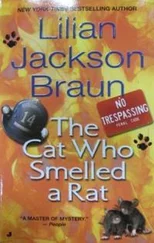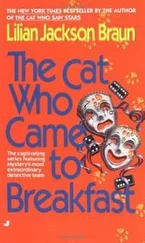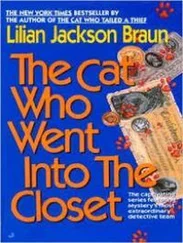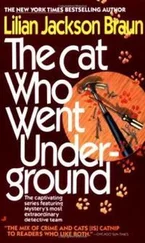“Our paths crossed briefly last summer,” Qwilleran said, “pleasant young woman.” Actually, he was wondering how this sweet, shy, soft-spoken personality, hidden under a mop of very long hair, could manage anything more dynamic than an old ladies’ home. He had met her at a residence for the widows of commercial fishermen.
“I’d like to see the facility,” he said to Kemple.
He followed the pickup truck to a side street in Black Creek, where a large barnlike building gleamed under a coat of white paint. Painted across the front were the words ANTIQUE VILLAGE. The large double doors were open, and rocking chairs, tables and hutch cabinets were being carried in.
“It’s been cleaned up a lot,” Kemple said. “We just painted everything white. If you have any suggestions, don’t hesitate to make them.”
The two long walls were lined with three-sided booths having wall space for wall furniture and hanging objects. Down the center of the hall were larger spaces divided by latticework, designed for freestanding furniture. Kemple said in a low rumble that passed for a whisper, “They pay less per square foot, and it encourages furniture displays. We want to get that kind of reputation—not just a barnful of knickknacks. Some of the large pieces coming in include an Art Deco dining table, an old square piano made into a desk, an eight-foot hutch cupboard, and a carved church pew.”
“Mr. Qwilleran!” came a woman’s voice, forceful but cordial. “Do you remember me? Janelle—from the Safe Harbor Residence.”
“Of course I remember you,” he said, concealing his surprise. Two years of college, contact with the workaday world, and a businesslike haircut had given her a managerial briskness that disguised her petite stature.
The boss said, “Janelle, show him around. I have to make a few phone calls.”
“Have you seen the recycled furniture?” she asked. “A young man in Sawdust City makes shutters, doors, small windows, railings and mantels into tables, desks, cabinets, chests, and so forth. They’re wonderful in beach houses and fun accents anywhere.”
The mismatched components of each piece were given a coat of paint to tie everything together. White, terra-cotta and moss green were among the colors the creator had chosen.
“What do you think?” Janelle asked.
“Certainly original. Some are quite witty. They’ll appeal to people who don’t take themselves too seriously.”
From somewhere came an impudent cry, “Cuckoo! Cuckoo!”
“Who said that?” Qwilleran demanded with facetious indignation.
Giggling slightly, she said it was one of Arnold’s clocks. “He has shops in Lockmaster and Mooseville, but he likes the idea of having a booth in a mall.”
On display in Arnold’s booth were brass andirons, cranberry glass candlesticks, Oriental scatter rugs with the mellowness of age, a birdcage made of twigs, framed engravings of Niagara Falls and the Hudson River, several pressed-wood kitchen clocks ticking loudly, and a cuckoo clock like the one Gus Limburger had promised to his handyman.
Across the hall a dealer called for Janelle, and she excused herself to go and help. Qwilleran looked around and was attracted to a locked glass case in which several curiosities were displayed: a pair of bronze monkeys holding stubby candles, a tall brass oil lamp from India, a small pillow covered with a scrap of needlepoint worked with the date, 1847. The item that riveted his attention was a framed oil painting, about twelve by fifteen. It was a beach scene, obviously painted in the twenties, judging from the modest bathing attire.
“What is this display?” he asked Janelle when she returned.
“It’s a not-for-sale loan-exhibit. We’re having a sign made. The dealers are invited to show their personal treasures. Each one will have a label identifying the item and the owner. The oil painting is mine.”
“It has a haunting quality. How do you happen to own it?”
“It’s a long story! With kind of a spooky ending.”
“I’d like to hear it if you don’t mind.”
“Oh, I’d love to tell you!” she glanced at the growing activity in the hall.
“When you’re not busy,” he said quickly, “and when I have my tape recorder.”
“I could come in early tomorrow—nine thirty . . .”
“Done deal!” he said, as another dealer cried “Miss Van Roop!”
Kemple came out of the office. “How do you like what you see?”
“So far, so good. What’s the platform at the end of the hall?”
“It was used for auctions when the flea market was here, but they’ve been discontinued. We haven’t decided, yet, what to do with it.”
“How would you like a loan-exhibit of museum-quality black walnut furniture dated 1900—with a romantic history to boot?”
“Are you kidding me? Or what?”
“It belongs to the K Fund and needs a temporary home until the new museum is built. It’s heavily insured, of course.”
“I know. Anything the K Fund does is done right. What’ll they want from us?”
“Some kind of barrier around the edge of the platform, so the public has no access to the exhibit items.”
Kemple said, “Janelle’s boyfriend could build one out of old porch railings. He’s the guy who builds recycled furniture from bits and pieces of old houses. When would you be moving the stuff in? Maybe we should have an armed guard,” he added with a chuckle.
Qwilleran said, “Would you like to hand out leaflets telling the story behind the furniture. There’s an element of mystery about the three mirrors, all of which are cracked in the same unusual way.”
“This is getting better all the time. Where do we get those?”
“I have all the information,” Qwilleran said. “I’ll write the copy, and you can have it run off at the quick-print shop in Pickax.”
“Wait till my partner hears this!” Kemple said.
alt="[image]"/>Qwilleran returned home in high spirits. He had pulled strings, thrown his weight around, killed two birds with one stone, and told a couple of harmless fibs. By way of celebration he announced “Crabmeat tonight!” as the Siamese met him at the door.
First he called the attorney at home. “Bart, I won’t apologize for calling you at home on Sunday, because I know you’re eager for this information. The Antique Village that’s opening this weekend is a class-act under Ernie Kemple’s eagle eye, and they are interested in having our black walnut furniture as a loan-exhibit. We’d better insure it.”
“What’s its value?”
“Seventy-five thousand at least. It’s a hundred years old, of rare quality, and rich in legend.”
“Who can verify that?”
“Susan Exbridge.”
Next Qwilleran called the antique dealer at home. “Susan, if Allen Barter calls you about some hundred-year-old black walnut furniture with a red-hot provenance, it’s okay to say it’s worth seventy-five thousand. I’ll explain to you later.”
“Anything you say, darling,” she purred.
“Have you heard they’re going to build a historical museum? I’m sure they’ll want you to be on the board of directors.”
Finally he called Nick Bamba. “I’ve found a new home for the black walnut furniture that we moved to Sandpit Road. It will be a loan-exhibit at the Antique Village. They’ll be ready for it this week. Can you accommodate them when they call? Eventually it will move to the museum being built—but don’t repeat this. It won’t be officially announced until the right location is found.”
Qwilleran hung up with satisfaction. Starting an unfounded rumor was one of the chief pleasures 400 miles north of everywhere.
At six o’clock he ambled along the creek to Cabin One, where the Underhills were waiting outside Hannah’s porch.
Читать дальше












